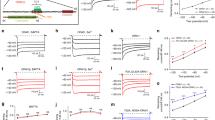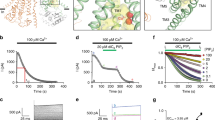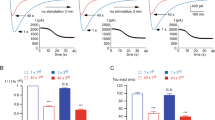Abstract
Phosphatidylinositol bisphosphate (PIP2) regulates the activities of many membrane proteins, including ion channels, through direct interactions. However, the affinity of PIP2 is so high for some channel proteins that its physiological role as a modulator has been questioned. Here we show that PIP2 is a key cofactor for activation of small conductance Ca2+-activated potassium channels (SKs) by Ca2+-bound calmodulin (CaM). Removal of the endogenous PIP2 inhibits SKs. The PIP2-binding site resides at the interface of CaM and the SK C terminus. We further demonstrate that the affinity of PIP2 for its target proteins can be regulated by cellular signaling. Phosphorylation of CaM T79, located adjacent to the PIP2-binding site, by casein kinase 2 reduces the affinity of PIP2 for the CaM–SK channel complex by altering the dynamic interactions among amino acid residues surrounding the PIP2-binding site. This effect of CaM phosphorylation promotes greater channel inhibition by G protein–mediated hydrolysis of PIP2.
This is a preview of subscription content, access via your institution
Access options
Subscribe to this journal
Receive 12 print issues and online access
$259.00 per year
only $21.58 per issue
Buy this article
- Purchase on Springer Link
- Instant access to full article PDF
Prices may be subject to local taxes which are calculated during checkout






Similar content being viewed by others

References
Suh, B.-C. & Hille, B. PIP2 is a necessary cofactor for ion channel function: How and Why? Annu. Rev. Biophys. 37, 175–195 (2008).
Delmas, P. & Brown, D.A. Pathways modulating neural KCNQ/M (Kv7) potassium channels. Nat. Rev. Neurosci. 6, 850–862 (2005).
Logothetis, D., Petrou, V., Adney, S. & Mahajan, R. Channelopathies linked to plasma membrane phosphoinositides. Pflugers Arch. 460, 321–341 (2010).
Tucker, S.J. & Baukrowitz, T. How highly charged anionic lipids bind and regulate ion channels. J. Gen. Physiol. 131, 431–438 (2008).
Michailidis, I.E. et al. Phosphatidylinositol-4,5-bisphosphate regulates epidermal growth factor receptor activation. Pflugers Arch. 461, 387–397 (2011).
Hernandez, C.C., Zaika, O., Tolstykh, G.P. & Shapiro, M.S. Regulation of neural KCNQ channels: signalling pathways, structural motifs and functional implications. J. Physiol. (Lond.) 586, 1811–1821 (2008).
Roberts-Crowley, M.L., Mitra-Ganguli, T., Liu, L. & Rittenhouse, A.R. Regulation of voltage-gated Ca2+ channels by lipids. Cell Calcium 45, 589–601 (2009).
Rosenhouse-Dantsker, A. & Logothetis, D. Molecular characteristics of phosphoinositide binding. Pflugers Arch. 455, 45–53 (2007).
Kruse, M., Hammond, G.R. & Hille, B. Regulation of voltage-gated potassium channels by PI(4,5)P2 . J. Gen. Physiol. 140, 189–205 (2012).
Köhler, M. et al. Small-conductance, calcium-activated potassium channels from mammalian brain. Science 273, 1709–1714 (1996).
Faber, E.S.L. & Sah, P. Functions of SK channels in central neurons. Clin. Exp. Pharmacol. Physiol. 34, 1077–1083 (2007).
Stocker, M. Ca2+-activated K+ channels: molecular determinants and function of the SK family. Nat. Rev. Neurosci. 5, 758–770 (2004).
Xu, Y. et al. Molecular identification and functional roles of a Ca2+-activated K+ channel in human and mouse hearts. J. Biol. Chem. 278, 49085–49094 (2003).
Adelman, J.P., Maylie, J. & Sah, P. Small-conductance Ca2+-activated K+ channels: form and function. Annu.Rev. Physiol. 74, 245–269 (2012).
Giessel, A.J. & Sabatini, B.L. M1 muscarinic receptors boost synaptic potentials and calcium influx in dendritic spines by inhibiting postsynaptic SK channels. Neuron 68, 936–947 (2010).
Maingret, F. et al. Neurotransmitter modulation of small-conductance Ca2+-activated K+ channels by regulation of Ca2+ gating. Neuron 59, 439–449 (2008).
Buchanan, K.A., Petrovic, M.M., Chamberlain, S.E.L., Marrion, N.V. & Mellor, J.R. Facilitation of long-term potentiation by muscarinic M1 receptors is mediated by inhibition of SK channels. Neuron 68, 948–963 (2010).
Faber, E.S.L. Functional interplay between NMDA receptors, SK channels and voltage-gated Ca2+ channels regulates synaptic excitability in the medial prefrontal cortex. J. Physiol. (Lond.) 588, 1281–1292 (2010).
Mpari, B., Sreng, L., Manrique, C. & Mourre, C. KCa2 channels transiently downregulated during spatial learning and memory in rats. Hippocampus 20, 352–363 (2010).
Kramár, E.A. et al. A novel mechanism for the facilitation of φ-induced long-term potentiation by brain-derived neurotrophic factor. J. Neurosci. 24, 5151–5161 (2004).
Stackman, R.W. et al. Small conductance Ca2+-activated K+ channels modulate synaptic plasticity and memory encoding. J. Neurosci. 22, 10163–10171 (2002).
McKay, B.M., Oh, M.M. & Disterhoft, J.F. Learning increases intrinsic excitability of hippocampal interneurons. J. Neurosci. 33, 5499–5506 (2013).
Garland, C.J. Compromised vascular endothelial cell SKCa activity: a fundamental aspect of hypertension? Br. J. Pharmacol. 160, 833–835 (2010).
Köhler, R. Single-nucleotide polymorphisms in vascular Ca2+ activated K+-channel genes and cardiovascular disease. Pflugers Arch. 460, 343–351 (2010).
Allen, D. et al. SK2 channels are neuroprotective for ischemia-induced neuronal cell death. J. Cereb. Blood Flow Metab. 31, 2302–2312 (2011).
Chou, C.C., Lunn, C.A. & Murgolo, N.J. KCa3.1: target and marker for cancer, autoimmune disorder and vascular inflammation? Expert Rev. Mol. Diagn. 8, 179–187 (2008).
Kasumu, A.W. et al. Selective positive modulator of calcium-activated potassium channels exerts beneficial effects in a mouse model of spinocerebellar ataxia type 2. Chem. Biol. 19, 1340–1353 (2012).
Zhang, M. et al. Structural basis for calmodulin as a dynamic calcium sensor. Structure 20, 911–923 (2012).
Xia, X.M. et al. Mechanism of calcium gating in small-conductance calcium-activated potassium channels. Nature 395, 503–507 (1998).
Zhang, M., Pascal, J.M. & Zhang, J.F. Unstructured to structured transition of an intrinsically disordered protein peptide in coupling Ca2+-sensing and SK channel activation. Proc. Natl. Acad. Sci. USA 110, 4828–4833 (2013).
Allen, D., Fakler, B., Maylie, J. & Adelman, J.P. Organization and regulation of small conductance Ca2+-activated K+ channel multiprotein complexes. J. Neurosci. 27, 2369–2376 (2007).
Bildl, W. et al. Protein kinase CK2 is coassembled with small conductance Ca2+-activated K+ channels and regulates channel gating. Neuron 43, 847–858 (2004).
Wagner, E.J., Rønnekleiv, O.K. & Kelly, M.J. The noradrenergic inhibition of an apamin-sensitive, small-conductance Ca2+-activated K+ channel in hypothalamic γ-aminobutyric acid neurons: pharmacology, estrogen sensitivity, and relevance to the control of the reproductive axis. J. Pharmacol. Exp. Ther. 299, 21–30 (2001).
Zhang, M., Pascal, J.M., Schumann, M., Armen, R.S. & Zhang, J.F. Identification of the functional binding pocket for compounds targeting small-conductance Ca2+-activated potassium channels. Nat. Commun. 3, 1021 (2012).
Zhang, H. et al. PIP2 activates KCNQ channels, and its hydrolysis underlies receptor-mediated inhibition of M currents. Neuron 37, 963–975 (2003).
Rohács, T. et al. Specificity of activation by phosphoinositides determines lipid regulation of Kir channels. Proc. Natl. Acad. Sci. USA 100, 745–750 (2003).
Rosenhouse-Dantsker, A. et al. A sodium-mediated structural switch that controls the sensitivity of Kir channels to PtdIns(4,5)P2 . Nat. Chem. Biol. 4, 624–631 (2008).
Hansen, S.B., Tao, X. & MacKinnon, R. Structural basis of PIP2 activation of the classical inward rectifier K+ channel Kir2.2. Nature 477, 495–498 (2011).
Murata, Y., Iwasaki, H., Sasaki, M., Inaba, K. & Okamura, Y. Phosphoinositide phosphatase activity coupled to an intrinsic voltage sensor. Nature 435, 1239–1243 (2005).
Pedarzani, P. et al. Specific enhancement of SK channel activity selectively potentiates the afterhyperpolarizing current IAHP and modulates the firing properties of hippocampal pyramidal neurons. J. Biol. Chem. 280, 41404–41411 (2005).
Horn, R. Electrifying phosphatases. Sci. STKE 2005, pe50 (2005).
Iwasaki, H. et al. A voltage-sensing phosphatase, Ci-VSP, which shares sequence identity with PTEN, dephosphorylates phosphatidylinositol 4,5-bisphosphate. Proc. Natl. Acad. Sci. USA 105, 7970–7975 (2008).
Henzler-Wildman, K. & Kern, D. Dynamic personalities of proteins. Nature 450, 964–972 (2007).
Kobilka, B.K. Structural insights into adrenergic receptor function and pharmacology. Trends Pharmacol. Sci. 32, 213–218 (2011).
Rosenbaum, D.M., Rasmussen, S.G.F. & Kobilka, B.K. The structure and function of G protein–coupled receptors. Nature 459, 356–363 (2009).
Nygaard, R?. et al. The dynamic process of β2-adrenergic receptor activation. Cell 152, 532–542 (2013).
Martina, M., Turcotte, M.-E.B., Halman, S. & Bergeron, R. The σ-1 receptor modulates NMDA receptor synaptic transmission and plasticity via SK channels in rat hippocampus. J. Physiol. (Lond.) 578, 143–157 (2007).
Hammond, R.S. et al. Small-conductance Ca2+-activated K+ channel type 2 (SK2) modulates hippocampal learning, memory, and synaptic plasticity. J. Neurosci. 26, 1844–1853 (2006).
Blank, T., Nijholt, I., Kye, M.-J., Radulovic, J. & Spiess, J. Small-conductance, Ca2+-activated K+ channel SK3 generates age-related memory and LTP deficits. Nat. Neurosci. 6, 911–912 (2003).
Winter, G. Xia2: an expert system for macromolecular crystallography data reduction. J. Appl. Crystallogr. 43, 186–190 (2010).
Emsley, P. & Cowtan, K. Coot: model-building tools for molecular graphics. Acta Crystallogr. D Biol. Crystallogr. 60, 2126–2132 (2004).
Collaborative Computational Project, Number 4. The CCP4 suite: programs for protein crystallography. Acta Crystallogr. D Biol. Crystallogr. 50, 760–763 (1994).
Adams, P.D et al. PHENIX: a comprehensive Python-based system for macromolecular structure solution. Acta Crystallogr. D Biol. Crystallogr. 66, 213–221 (2010).
Winn, M.D. et al. Overview of the CCP4 suite and current developments. Acta Crystallogr. D Biol. Crystallogr. 67, 235–242 (2011).
Peralta, E.G., Ashkenazi, A., Winslow, J.W., Ramachandran, J. & Capon, D.J. Differential regulation of PI hydrolysis and adenylyl cyclase by muscarinic receptor subtypes. Nature 334, 434–437 (1988).
Morris, G.M. et al. Automated docking using a Lamarckian genetic algorithm and an empirical binding free energy function. J. Comput. Chem. 19, 1639–1662 (1998).
Breneman, C.M. & Wiberg, K.B. Determining atom-centered monopoles from molecular electrostatic potentials—the need for high sampling density in formamide conformational analysis. J. Comput. Chem. 11, 361–373 (1990).
Frisch, M.J. et al. Gaussian 98 (Gaussian, Inc., 2001).
Meng, X.-Y., Zhang, H.-X., Logothetis, D.E. & Cui, M. The Molecular mechanism by which PIP2opens the intracellular G-loop gate of a Kir3.1 channel. Biophys. J. 102, 2049–2059 (2012).
Bowers, K.J. et al. in Proceedings of the ACM/IEEE Conference on Supercomputing (SC06) 11–17 (2006).
Acknowledgements
We thank J. Adelman, R. Horn, I. Levitan and S. Siegelbaum for their helpful discussions and comments on this work. We thank M. Eto for advice on the in vitro phosphorylation assay. We thank J.P. Bennett Jr. and L. O'Brien for sharing their mammalian cell patch clamp setup. We are grateful to H. Vaananen for technical assistance. We thank I.S. Ramsey for the HEK-293 stably transfected cell line with the muscarinic M1 receptor, the structural facility of the Kimmel Cancer Center of Thomas Jefferson University for access of equipment in initial protein crystal screening and initial in-house X-ray diffraction; staff at the Beamline facility (X6A) of the Brookhaven National labs for assistance with collection of X-ray diffraction data. The use of the National Synchrotron Light Source, Brookhaven National Laboratory, was supported by the US Department of Energy, Office of Science, Office of Basic Energy Sciences, under contract no. DE-AC02-98CH10886. This work was partly supported by grants 13SDG16150007 from the American Heart Association to M.Z., S10RR027411 from the US National Institutes of Health (NIH) to M.C., HL059949 and HL090882 from NIH to D.E.L. and R01MH073060 and R01NS39355 from NIH to J.F.Z.
Author information
Authors and Affiliations
Contributions
M.Z., D.E.L. and J.-F.Z. designed the experiments. M.Z. performed electrophysiology and biochemistry experiments and carried them out. X.-Y.M. and M.C. performed the docking and MD simulations. M.Z., J.-F.Z. and J.M.P. performed experiments of X-ray crystallography. M.Z. and J.-F.Z. analyzed the data, made figures and wrote the first draft of the manuscript. All of the authors participated in revising the first draft into its final form.
Corresponding authors
Ethics declarations
Competing interests
The authors declare no competing financial interests.
Supplementary information
Supplementary Text and Figures
Supplementary Results, Supplementary Figures 1–8 and Supplementary Table 1 (PDF 1719 kb)
Rights and permissions
About this article
Cite this article
Zhang, M., Meng, XY., Cui, M. et al. Selective phosphorylation modulates the PIP2 sensitivity of the CaM–SK channel complex. Nat Chem Biol 10, 753–759 (2014). https://doi.org/10.1038/nchembio.1592
Received:
Accepted:
Published:
Issue Date:
DOI: https://doi.org/10.1038/nchembio.1592
This article is cited by
-
The regulation of the small-conductance calcium-activated potassium current and the mechanisms of sex dimorphism in J wave syndrome
Pflügers Archiv - European Journal of Physiology (2021)
-
Structural insights on TRPV5 gating by endogenous modulators
Nature Communications (2018)
-
A V-to-F substitution in SK2 channels causes Ca2+ hypersensitivity and improves locomotion in a C. elegans ALS model
Scientific Reports (2018)
-
Structural insights into the potency of SK channel positive modulators
Scientific Reports (2017)
-
Modulation of Kv7 channels and excitability in the brain
Cellular and Molecular Life Sciences (2017)


